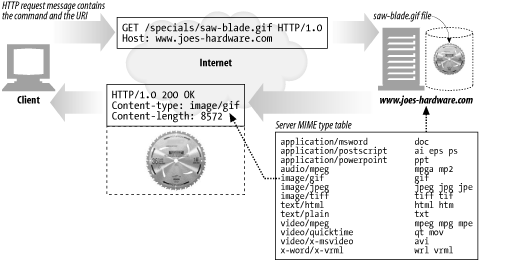Step 5: Building Responses
Once the web server has identified the resource, it performs the action described in the request method and returns the response message. The response message contains a response status code, response headers, and a response body if one was generated. HTTP response codes were detailed in Section 3.4 in Chapter 3.
Response Entities
If the transaction generated a response body, the content is sent back with the response message. If there was a body, the response message usually contains:
A Content-Type header, describing the MIME type of the response body
A Content-Length header, describing the size of the response body
The actual message body content
MIME Typing
The web server is responsible for determining the MIME type of the response body. There are many ways to configure servers to associate MIME types with resources:
- mime.types
The web server can use the extension of the filename to indicate MIME type. The web server scans a file containing MIME types for each extension to compute the MIME type for each resource. This extension-based type association is the most common; it is illustrated in Figure 5-12.

Figure 5-12. A web server uses MIME types file to set outgoing Content-Type of resources
- Magic typing
The Apache web server can scan the contents of each resource and pattern-match the content against a table of known patterns (called the magic file) to determine ...
Get HTTP: The Definitive Guide now with the O’Reilly learning platform.
O’Reilly members experience books, live events, courses curated by job role, and more from O’Reilly and nearly 200 top publishers.

